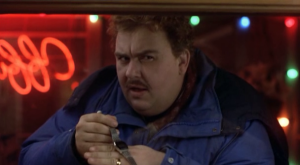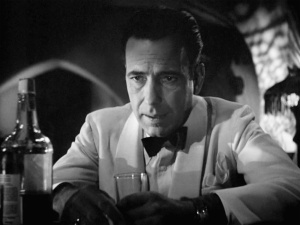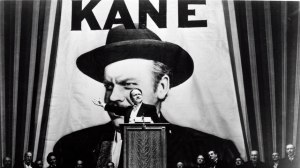
Candy Hurlant
I miss John Candy. There are some days when I catch a movie of his on TV and that’s all I think about as he’s on screen. He had such a likeable, lovable and friendly presence, even when he was playing somewhat smarmy guys, which was very rare. This past March marked the 21st anniversary of his death, and it seems to me that his film memory is fading. There’s an entire generation who doesn’t know who he is. Sure, they’ll catch him in something from time to time, like “Stripes”, but their focus is most assuredly on Bill Murray. And a lot of Candy’s starring vehicles don’t get much playtime nowadays. It’s sad to think that kids today won’t know the joys of “Uncle Buck” or “The Great Outdoors” on a lazy Saturday afternoon. Let’s hope their parents do the right thing and introduce them to a great and funny actor, the same way my parents introduced us kids to such classics like “Lillies of the Field” and “To Sir, With Love”.
In my family, John Candy is still very much alive. Every Thanksgiving, along with “March of the Wooden Soldiers” and “Mystery Science Theater 3000”, a viewing of “Planes, Trains and Automobiles” is mandatory. And as many times as we’ve seen it, it never gets old. Candy is so good in this movie, ranging from being thoroughly annoying, grating, irresponsible, inventive… all culminating in that final moment when we realize how lonely he is, constantly staying on the road to distract him from the loss of his wife. And he never overplays any of these qualities, he just is. Like a goofy and affable Steve McQueen.
I grew up on John Candy, thanks to my parents. Even now when my family is together and we start laughing, my dad will wind up launching into his perfect impression of Candy’s chuckle. Which makes everyone in the room laugh even harder. Thinking back I can’t really remember the first time I saw Candy in a film or on TV. He always just seemed to be there, and it felt like he always would. In the mid-80’s we discovered “SCTV”, the Canadian answer of sorts to Saturday Night Live. But SCTV was always a little weirder and more off-the-wall. Focused around a fake television station in the fictional town of Melonville, “SCTV”‘s sketches centered around the conceit of programming, allowing performers like Rick Moranis, Catherine O’Hara and Harold Ramis, just to name a few, the ability to play tons of characters, both original and parodied, and to mess around with everything from talk shows to movies. And Candy was at the center of it. He brought so many hysterical, and sometimes strange, personas to the table. Yosh Shmenge, Divine, Orson Welles, Luciano Pavarotti, Julia Child, and my personal favorite, Angel Cortez, FBI Jockey. The list goes on and on and on. His gift for character work and mimicry seemed limitless, and if you ever get the chance, seek out the Canadian broadcast versions of SCTV. Your brow may furrow at just how strange it can be sometimes, but you’ll always have a smile on your face.
Around this time, John Candy started to land some great supporting film roles. I already mentioned “Stripes”, but he’s also memorable in such comedy classics as “National Lampoon’s Vacation”, “Splash” and “The Blues Brothers”. (“Orange whip? Orange whip? Three orange whips!”) Pretty soon, by the mid 1980’s, Candy was carrying his own films, becoming a bonafide movie star and box office draw, working with some of Hollywood’s biggest and brightest. During pre-production of “Ghostbusters” he was even tapped to play Louis Tully, Dana Barrett’s nerdy neighbor. His take on the character was very different from Rick Moranis’ now classic portrayal and ultimately clashed with what director Ivan Reitman wanted; Candy wanted to play Tully as a German who kept Dobermans. His involvement in the movie was such that storyboards exist featuring him as Tully, and the actor appeared as himself in the Ray Parker Jr. music video of the title song.
One of my very favorite John Candy performances is in the cult, midnight movie “Heavy Metal”. Now by the time I first saw this film I was in junior high, and “Heavy Metal” was already the stuff of legend. My friends would tell me about this unbelievable cartoon that had violence, aliens, rock n’ roll and plenty of buxom, naked chicks running around. And everytime it appeared in conversation, the phrase “and John Candy is in it!” would always pop up. If you grew up in the 80’s as an adolescent, geeky lad, like I did, this movie was like the Holy Grail. Released in 1981, “Heavy Metal” never officially found a home on VHS, and then DVD, until the mid to late 90’s. Because of all the different recording artists, such as Black Sabbath, Blue Oyster Cult, and even some very non-metal acts like Stevie Knicks, Glenn Frey and Don Felder, contributing to the soundtrack, the rights to release it on home video became tied up for years. After its brief theatrical run it was damn near impossible to see it. Unless you wanted to pay hundreds of dollars for a bootleg copy, or stay up all night to catch a rare broadcast of it on HBO or Cinemax, which my family didn’t have. I remember running into a kid I knew from school at a Star Trek convention in 1991; his name escapes me, but I recall he looked like the 7th grade equivalent of Sam Kinison. To me at least. So anyways, he runs up to me, hyperventilating and excited, because his uncle just scored a copy of “Heavy Metal” on VHS from a vendor, bragging about how he paid something like a few hundred bucks for it. I was envious, still not having seen it, but any chance of viewing his uncle’s copy vanished when my friend exclaimed something about “all the cartoon titties bouncing around” in front of my mom. And just for the record, cartoon titties never turned me on. I prefer the real ones. You get less ink on your hands.
About a year later, I was sleeping over at my friend Jed’s house, along with a few other buddies. We were cool, man. Staying up all night, playing Dungeons & Dragons, watching horror movies, listening to Iron Maiden and The Sex Pistols (on vinyl, no less) and perusing his older brother Zach’s collection of Heavy Metal magazines, which the movie was inspired by. (Side note: Jed and Zach’s full names were Jedediah and Zachariah. His parents were neither religious or Amish. Figure that one out.) The magazine blew me away. Great stories and comics, ranging from hard sci-fi to Robert E. Howard style fantasy tales. All spiked with nudity, sex and violence. What more could a skinny 13-year-old with thick glasses ask for? Now I had to see this movie. And one night, at Jed’s, I did.
It must’ve been really late at night because I had already fallen asleep, and we tended to stay up way past the midnight hour. Jed was shaking me out of my slumber, whispering excitedly “dude, dude! ‘Heavy Metal’ is on!” I don’t think I’ve ever sprung to life quicker, and within moments I was viewing the rarest of geek-centric movies, losing myself in the different stories that revolved around the mysterious, powerful and destructive green orb known as the Loc-Nar. And of course, losing myself in major boobage, which years later would become the title of the South Park episode that paid tribute to this movie. I have to say that at first, I was disappointed. The animation wasn’t of the highest quality, and each segment was done by different animation houses as well, so it all seemed a bit disjointed. At first. It took some time during that initial viewing to get used to the style, and once I realized that it was a cinematic version of the anthology format of the magazine, I became totally lost in it. It had everything – dystopian noir, stoner aliens, Cheap Trick, sexy girls, WWII era zombies. All of what a growing boy needs. It seemed to be this irreverent slap in the face, like a sci-fi/fantasy filled punk rock song, put to a soaring, adventurous score by Elmer Bernstein. By the time it was over I wanted, needed, to see it again. And I wouldn’t get my chance until the end of my senior year in high school when it was finally released on video. To this day I can watch it anytime, anywhere and with anyone. Except my mom.
Which brings me back to John Candy. One of the joys of watching “Heavy Metal” is his voice over performance in the segment titled “Den”. (Candy also provided a few other voices in the film, including a robot skilled in “highly proficient sex”) Based on the Richard Corbin story featured in the magazine, “Den” was about a nerdy, skinny kid who finds the Loc-Nar in his backyard one night and it magically transports him to a far off planet, turning him into a muscle bound hero named Den. Throughout his adventures, Den battles barbarians, monsters and even beds a few bouncy beauties in the process. As the character, Candy narrates the tale with the inner thoughts of the still dorky and awkward Den, reveling in his exploits and his new-found luck with the ladies. (“Wow, 18 years of nothing, and now twice in one day! What a place!”) This story was always, to me, the quintessential adolescent geek fantasy. You’re plucked out of your Earthbound, wimpy existence and wake up a near-invincible hero, saving the damsel in distress and in the process becoming a legend. All without breaking a sweat.
Out of all of John Candy’s roles, Den has always resonated with me the most. I was an awkward kid, never comfortable in my body. I was skinny, had glasses, into Star Trek and NASA, a real nerd. I’d get made fun of, even bullied, and because my dad was an officer in the Army my family moved all the time, so I was always the new kid. I’d get lost in sci-fi, fantasy and horror books, comics and movies, fantasizing about being a cooler than cool hero. I think any kid like me who grew up in the era that I did dreamt about being Han Solo, Conan the Barbarian, Rambo… but ultimately we were Lewis Skolnick at best. “Den”, for me, put a face on the fantasy I never knew I had; to be spirited away and miraculously gifted with abilities I could only dream of possessing. I still dream about those things.
And more often than not, I hear John Candy’s voice, summing it all up beautifully:
“On Earth, I’m nobody. But here, I’m Den.”































